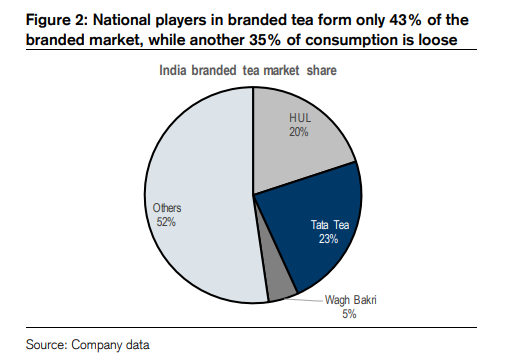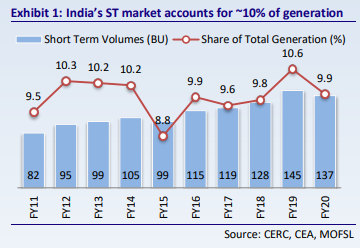
Thread on Tata Consumer Products🧵
Market cap: 58,030 crores
Revenues: 9,637 crores
P/E: 79.90
P/B: 4.14
P/S: 6.02
Here we go 👇
1/24
Market cap: 58,030 crores
Revenues: 9,637 crores
P/E: 79.90
P/B: 4.14
P/S: 6.02
Here we go 👇
1/24
India tea and salt form TCL's core and are steady high single-digit growth businesses:
In salt, TCL is the only national player with ~30% market share;
Furthermore, with a capacity not a constraint anymore, salt volume growth could accelerate;
2/24
In salt, TCL is the only national player with ~30% market share;
Furthermore, with a capacity not a constraint anymore, salt volume growth could accelerate;
2/24
The standalone business houses the India branded consumer products contributed ~62% to revenues and ~65% to EBIT in FY20;
On net income, the contribution of standalone is higher, at ~78%;
The core for the standalone business is packaged tea and branded salt,-
3/24

On net income, the contribution of standalone is higher, at ~78%;
The core for the standalone business is packaged tea and branded salt,-
3/24


-which form 90% of standalone sales and nearly 100% of standalone profits.
New food businesses and Starbucks are long-term prospects:
Branded pulses and spices have high growth potential as the branded share is very low at 1% for pulses and 30% for spices.
4/24

New food businesses and Starbucks are long-term prospects:
Branded pulses and spices have high growth potential as the branded share is very low at 1% for pulses and 30% for spices.
4/24


India tea, salt form TCL's core -profitable and stable:
The India tea and salt business contribute ~68% to TCL's EBITDA;
The key driver for tea and salt is share gain from loose consumption and smaller brands which form the majority of these categories;
5/24
The India tea and salt business contribute ~68% to TCL's EBITDA;
The key driver for tea and salt is share gain from loose consumption and smaller brands which form the majority of these categories;
5/24

In tea, ~35% of the market is loose tea and ~58% of the branded market is not with national players;
Capacity constraints which were in the past an impediment for growth in salt, have been taken care of with planned capacity expansion over FY19-24 at
~8% CAGR.
6/24

Capacity constraints which were in the past an impediment for growth in salt, have been taken care of with planned capacity expansion over FY19-24 at
~8% CAGR.
6/24


The branded packaged share is ~1% for pulses and ~30% for spices;
TCL's reported ROCE is low at 5%, however adjusting for the goodwill and intangible assets, the operational ROIC is 25% in FY20.
The tea category overall has very high penetration and may not grow at more than
TCL's reported ROCE is low at 5%, however adjusting for the goodwill and intangible assets, the operational ROIC is 25% in FY20.
The tea category overall has very high penetration and may not grow at more than
low single digits;
However, packaged tea is expected to grow faster and national brands are likely to grow even faster than packaged tea.
The following are the growth drivers for national brands:
Conversion of loose to branded tea,
Movement from local brands to
8/24
However, packaged tea is expected to grow faster and national brands are likely to grow even faster than packaged tea.
The following are the growth drivers for national brands:
Conversion of loose to branded tea,
Movement from local brands to
8/24
national players, and premiumization. National brands hold only ~42% share in the branded tea market.
The duopoly of national players- TCL lost market share in FY19 to HUL but regained the initiative in FY20:
TCL has a slightly larger volume market share, while HUL has
9/24

The duopoly of national players- TCL lost market share in FY19 to HUL but regained the initiative in FY20:
TCL has a slightly larger volume market share, while HUL has
9/24


a larger value share; TCL is stronger in north India while HUL is stronger in south India.
Green tea an emerging opportunity for TCL:
Green tea is a small segment of Rs 4bn within the large Rs 250bn packaged tea category in India;
10/24
Green tea an emerging opportunity for TCL:
Green tea is a small segment of Rs 4bn within the large Rs 250bn packaged tea category in India;
10/24
It contributes less than 2% to the overall tea market in India, compared to ~25% of the tea market globally;
While it is small, the segment experienced more than a 20% CAGR over FY15-20;
TCL has a market share of ~25% in green tea through the Tetley brand & is expected
11/24
While it is small, the segment experienced more than a 20% CAGR over FY15-20;
TCL has a market share of ~25% in green tea through the Tetley brand & is expected
11/24
to gain from the long-term growth of this segment.
Tata salt- Business restructuring sets the stage for faster growth:
Tata is the most dominant national brand with ~65% share within a branded players.
12/24
Tata salt- Business restructuring sets the stage for faster growth:
Tata is the most dominant national brand with ~65% share within a branded players.
12/24

Advertising and retailer advantage:
Matching Tata on advertising spend to create a similar brand image would entail several years of low profitability for a competitor;
Tata's brand pulls in turn generate significant leeway with retailers.
13/24
Matching Tata on advertising spend to create a similar brand image would entail several years of low profitability for a competitor;
Tata's brand pulls in turn generate significant leeway with retailers.
13/24
TCL has guided for 2-3% of revenues as synergy gains from the merger of the salt and tea businesses. The key sources of the synergy benefits are: (1) better absorption of fixed costs on a larger India turnover and (2) gains on distribution efficiencies and scale of procurement.
International businesses- slow-growing, but steady cash flows:
The International business consists of 3 main parts- US coffee, UK tea, and Canada Tea;
These are slow-growing as they are in developed markets and the black tea category is not a growth category in these markets;
The International business consists of 3 main parts- US coffee, UK tea, and Canada Tea;
These are slow-growing as they are in developed markets and the black tea category is not a growth category in these markets;
US Coffee-
TCL's key brand is 'Eight O'clock', EOC largely plays in the bag segment of the US coffee market, where it has more than a 10% share on the East coast, this business is very profitable and generates an EBITDA margin of ~18%;
16/24
TCL's key brand is 'Eight O'clock', EOC largely plays in the bag segment of the US coffee market, where it has more than a 10% share on the East coast, this business is very profitable and generates an EBITDA margin of ~18%;
16/24
UK and Canada Tea-
In the UK, has a ~30% market share of black tea and in Canada it has a ~50% share, TCL's share in the non-black tea market is much lower in both markets; the black tea market is not a growth market in these countries and thus growth rates are likely
17/24
In the UK, has a ~30% market share of black tea and in Canada it has a ~50% share, TCL's share in the non-black tea market is much lower in both markets; the black tea market is not a growth market in these countries and thus growth rates are likely
17/24
to be in the low single digits.
Distribution expansion a major low hanging driver from the TCL merger:
Tata sampann reaching merely 40,000 outlets compared to the direct reach of 700,000 outlets for TCL's tea business.
18/24
Distribution expansion a major low hanging driver from the TCL merger:
Tata sampann reaching merely 40,000 outlets compared to the direct reach of 700,000 outlets for TCL's tea business.
18/24

Spices are a more value-added profitable market, but TCL may need the inorganic route to scale up rapidly:
Unlike pulses, where there is relatively little differentiation in the end product, getting consistency in the end-product spices at scale is of significant value to
19/24
Unlike pulses, where there is relatively little differentiation in the end product, getting consistency in the end-product spices at scale is of significant value to
19/24
the consumer.
Tata Starbucks- a long-term prospect, Covid-19 hit in FY21 sets it back by a year:
It has more than doubled its stores from 85 to 180 over FY17-20;
Revenue has had a CAGR of 25% over the past 3 years and was ~5.6bn in FY20.
20/24

Tata Starbucks- a long-term prospect, Covid-19 hit in FY21 sets it back by a year:
It has more than doubled its stores from 85 to 180 over FY17-20;
Revenue has had a CAGR of 25% over the past 3 years and was ~5.6bn in FY20.
20/24


Sunil D'souza, the new CEO of Tata consumer, has been the managing director of Whirlpool India for 4 years, and prior to that had 15 years of experience at Pepsi; He thus comes with a good mix of leadership experience and FMCG food experience.
21/24
21/24

Strong competitive advantages in Tea/salt,
👉Production process
👉Distribution and packaging
👉Advertising and retailer advantage
Challenges in pulses:
👉Product is a wash-and-use one.
👉High price volatility and production skewed towards one season.
👉Long supply chain
22/24
👉Production process
👉Distribution and packaging
👉Advertising and retailer advantage
Challenges in pulses:
👉Product is a wash-and-use one.
👉High price volatility and production skewed towards one season.
👉Long supply chain
22/24
👉Competition from modern trade private labels
Positives including merger benefits include:
👉Distribution expansion a major low hanging driver from the TCL merger
👉Spices are a more value-added profitable market, but TCL may need the inorganic route to scale up rapidly
23/24
Positives including merger benefits include:
👉Distribution expansion a major low hanging driver from the TCL merger
👉Spices are a more value-added profitable market, but TCL may need the inorganic route to scale up rapidly
23/24
👉Potential entry into more food categories a long-term driver.
👉Scale benefits on fixed costs.
👉Scale benefits on procurement and terms of trade.
👉Revenue synergies from distribution and cross selling
End of thread 🧵
24/24
👉Scale benefits on fixed costs.
👉Scale benefits on procurement and terms of trade.
👉Revenue synergies from distribution and cross selling
End of thread 🧵
24/24
• • •
Missing some Tweet in this thread? You can try to
force a refresh







